Types of Pothos Plants (Epipremnum Aureum) & Identification (Pictures & Names)
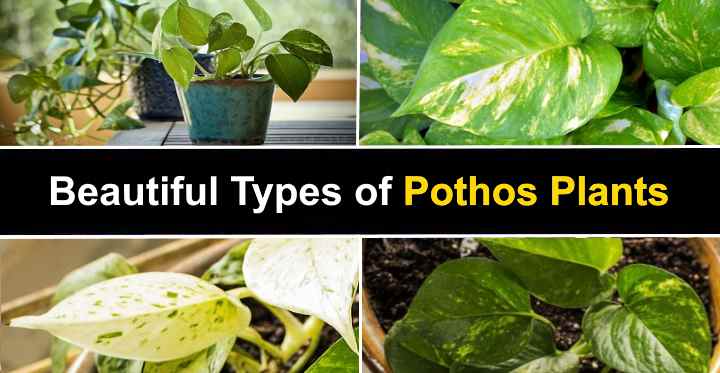
Pothos (Epipremnum aureum) is a type of tropical vine plant with long trailing stems and heart-shaped leaves. As a houseplant, pothos plants are easy to grow indoors with a minimal amount of care. The tropical indoor plants look stunning in hanging baskets or growing in pots. Pothos plants have several scientific and common names. So, identifying specific varieties is usually done by the type of variegation on their glossy, leathery leaves.
Pothos plants are commonly placed in the species Epipremnum aureum. However, in some countries, they are scientifically known as Scindapsus aureus, Rhaphidophora aurea, or Epipremnum pinnatum. In this article—to avoid confusion—we’ll refer to all pothos cultivars by their most common name Epipremnum aureum.
Just as there are several scientific names for pothos plants, they also have many common names. You may find plants in the Epipremnum aureum genus called devil’s ivy, silver vine, marble queen, taro vine, or golden pothos. Sometimes the common name refers to a characteristic of the plant—for example, neon pothos which has lime green leaves. Other times, it’s growth habit.
The plant is also mistakenly called a heartleaf philodendron; however, that is incorrect.
Types of pothos plants: The most common plants in the Epipremnum aureum genus are the Golden pothos, neon pothos, pearl and jade pothos, and marble queen pothos. The distinguishing feature between the types of pothos is their leaf variegation. Some plants have dark leaves, and other pothos have bright lemon and lime-colored leaves, and other have green and white leaves.
How to care for pothos plants: Devil’s ivy plants thrive in bright, indirect light when grown in moist potting soil with excellent drainage. For best growth, keep humidity levels high and temperatures between 65°F and 85°F (18°C – 29°C). Only water when the soil is partly dry, and prune the stems to encourage a bushier appearance. Fertilize monthly during the growing season.
Type of Pothos (With Pictures)
Let’s look in more detail at the various types of Epipremnum aureum. In this list, there are ten kinds of “true” pothos plants and two plants that have the common name pothos in their title. These two plants—satin pothos and Trebi pothos—are classified as Scindapsus pictus.
Jade Pothos
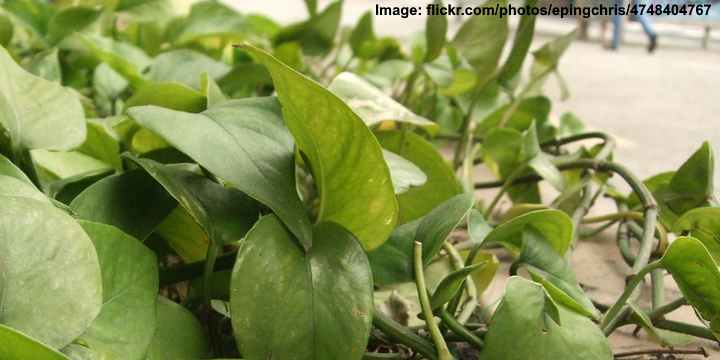
Epipremnum aureum ‘jade pothos’
Jade photos is the original type of pothos plant with only slight variegation on the dark green, heart shaped leaves. This type of pothos became popular as a houseplant because it is so easy to look after. Also commonly called the devil’s ivy, the dense foliage can be pruned to create an attractive tabletop plant.
Jade pothos plants—similar to all Epipremnum aureum plants—grow stems up to 3 ft. (90 cm) long indoors. These leafy vines cascade elegantly over a hanging basket. Or, the climbing plant can grow up a moss pole if you’re looking for a floor planter to provide a vertical accent.
Jade pothos grows well in bright light, as well as being a suitable plant for low light or shaded areas. Because it doesn’t need much sunlight and high humidity, jade pothos is an excellent shower plant for your bathroom.
Golden Pothos (Epipremnum aureum)
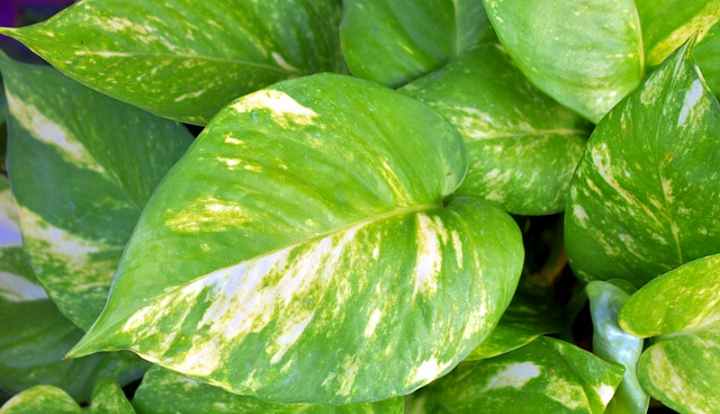
Picture of Epipremnum aureum (common name: Golden Pothos or Devils Ivy)
Golden pothos is one of the most popular types of hanging basket plants due to its light lime-colored leaves with yellow variegation. Its lemon-colored leaf patterns are like delicate brush strokes. Together with the glossy leaves, this pothos plant helps to brighten up shaded corners.
One of the outstanding features of the golden pothos is the fact that it’s an excellent low-light plant. Usually, plants with variegated leaves lose their vibrancy in low light. However, the golden pothos retains its bright variegation even in low light conditions. This fact makes golden pothos a suitable bedroom plant where light is usually limited.
Similar to all kinds of pothos plants, the golden pothos is on the list of clean air houseplants as recommended by NASA. (1)
Marble Queen Pothos
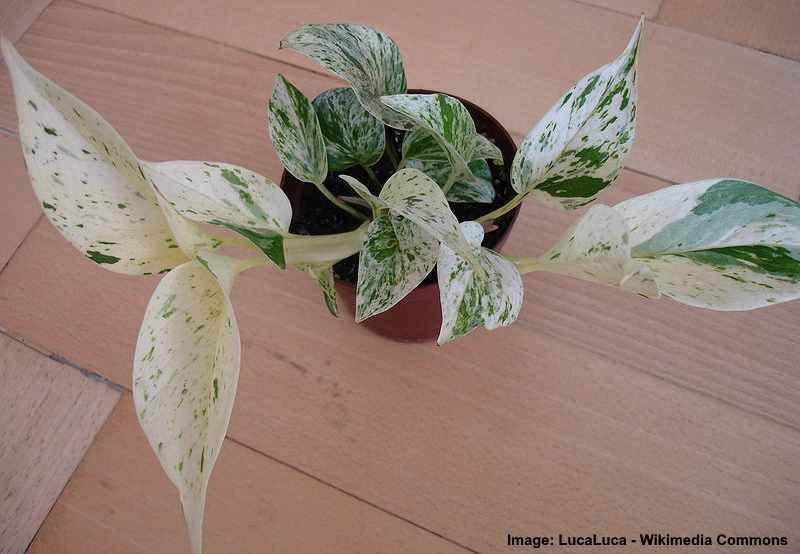
Epipremnum aureum ‘marble queen’ (marble queen pothos)
This Epipremnum aureum cultivar—the ‘Marble Queen’—has highly variegated leaves that are more cream-colored than green. This bright trailing plant has stunning marble foliage, creating an eye-catching showpiece in any room. Due to the deep variegation, this plant prefers growing in bright, indirect sunlight.
The marble pothos has slow growth rate, which can make caring for it easier. For example, the ‘Marble Queen’ has a bushy appearance and requires less pruning. Also, you don’t need to repot the plant as frequently as other pothos cultivars.
Neon Pothos
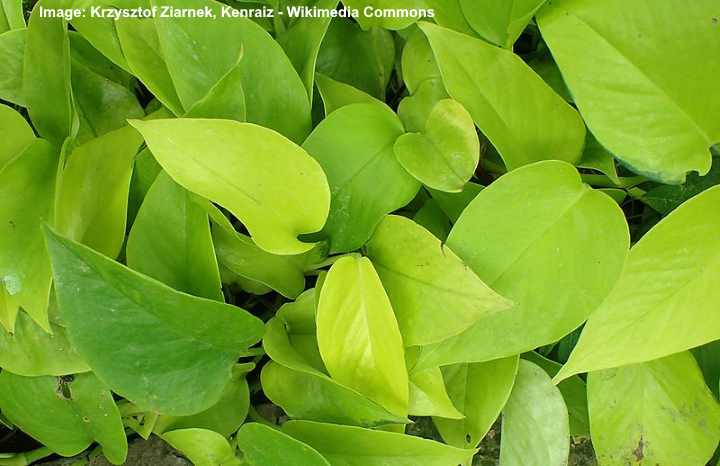
Epipremnum aureum ‘Neon Photos’
The neon pothos lives up to its common name due to the brightly-colored, almost translucent bright green leaves. Looking at pictures of this neon green pothos, you can’t help but be impressed by the electrifying bold color of the leaves and its bushy appearance.
Neon pothos plants are vigorous growers and are excellent in hanging baskets or containers on tall plant stands. You can also grow this pothos in water if you want to place it in a hard-to-reach location.
As with most variegated pothos plants, keep in a bright location with filtered light and only water when the top 1” (2.5 cm) of soil is dry.
Manjula Pothos (Epipremnum aureum ‘Manjula’)
The Manjula pothos is a stunning plant with beautiful cream and green leaves. The variegation is so stunning that some leaves are almost pure white, with only hints of green. Other leaves have a green and white marbled effect. Also called the Epipremnum ‘happy leaf,’ this plant is a patented variety of pothos.
It can be difficult to find a Manjula pothos in garden centers. This rare variegated pothos also has some specific care requirements to keep its foliage vibrant. It’s essential to keep the plant in a bright location but out of direct sunlight. Getting too much sunlight will cause the white variegation to fade.
Pearls and Jade Pothos
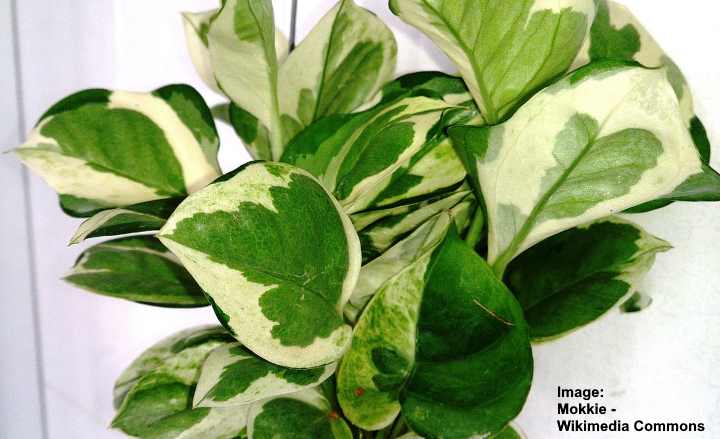
In the picture: Epipremnum aureum ‘Pearls and Jade’ (‘N’Joy’ pothos)
Also called the ‘N’Joy’ pothos, the Epipremnum aureum ‘Pearls and Jade’ is a small-leaf type of pothos. This variety has green and white variegation where leaves are emerald green with white, cream, and sometimes gray markings. Due to its slow growth, this plant is a great pot plant for a tabletop or office desk.
When it comes to pothos plant care, this cultivar is a little fussier than other pothos plants. While most kinds of pothos are partially drought-resistant plants, this variety needs the soil to be regularly moist. A sign of a lack of moisture will cause the pretty leaves to wilt.
Glacier Pothos
This slow-growing pothos—the ‘Glacier’ pothos—is a delightful vining plant with small heart-shaped leaves. The variegated foliage is green with silver and gray speckles which can be similar to ‘Pearls and Jade’ cultivar. Due to its bushy growth habit, the glacier pothos is an excellent potted plant for tables or desks.
The Epipremnum aureum ‘Glacier’ is similar in size to the ‘Pearl and Jade’ pothos. This variegated variety grows well even in low light conditions and can survive in average room humidity. However, keeping humidity levels high and in bright light will encourage faster growth.
Cebu Blue Pothos
One of the most unusual types of pothos is the ‘Cebu Blue’ cultivar. The distinctive feature of this Epipremnum variety is its elongated heart-shaped leaves. Rather than having a rounded shape, the leaves have a lanceolate shape. Unlike other pothos varieties, the ‘Cebu Blue’ has shiny silvery-blue foliage with interesting veined patterns.
As with caring for all types of pothos, this plant thrives in bright, indirect sunlight. Water the houseplant just enough to keep the soil slightly moist and keep humidity levels high.
Hawaiian Pothos
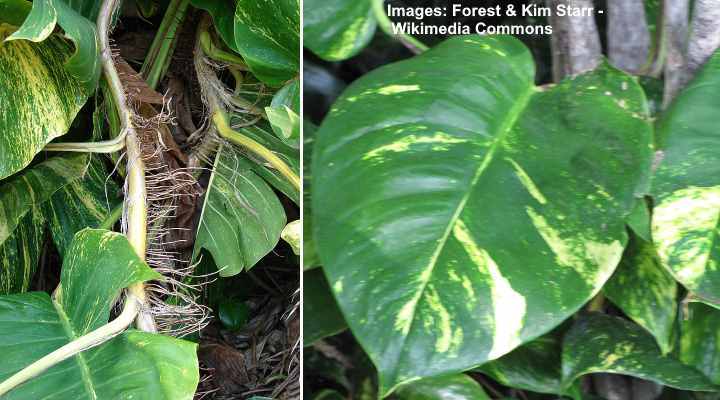
Epipremnum aureum Hawaiian
The Hawaiian pothos is a cultivar with huge leaves compared to other types of hanging pothos plants. The dark green foliage has speckles of yellow variegation. The long vines and large leaves create an attractive vertical accent when hanging from a basket or growing up a pole. Pruning can help to keep a compact growth habit and also control the stem length.
Jessenia Pothos
The cultivar Epipremnum aureum ‘Jessenia’ is a new pothos cultivar that is gaining popularity. The leaves are emerald green with lemon-yellow variegation. Some of the variegated leaves have a marbling effect, and others are almost pure golden yellow. Due to its popularity, the ‘Jessenia’ pothos is a rare, hard-to-find variety of houseplant.
Satin Pothos
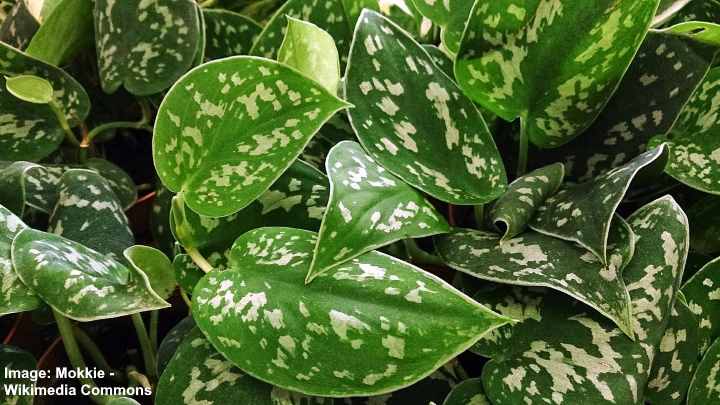
Scindapsus pictus ‘Argyraeus’ is commonly called satin pothos, silver pothos and silver Philodendron, but is not a true pothos nor Philodendron
Although it’s got the common name pothos, the satin pothos is not a true Epipremnum aureum plant. This cultivar is from the genus Scindapsus pictus. However, it has many of the common features of pothos that make them so popular. The satin pothos is a climbing plant with dark green matte foliage. The leaves have silvery spots, which is why it’s also named the silver satin pothos.
A common mistake when identifying the satin pothos is to confuse it with the Philodendron silver. Both of these plants have heart-shaped leaves and long, trailing vines. However, neither are from the genus Epipremnum and, therefore, are not true pothos plants.
Please read this article for detailed instructions on how to care for a satin pothos.
Trebi Pothos
The ‘Trebi’ pothos is related to the satin pothos as it’s also from the genus Scindapsus. This means that the ‘Trebi’ cultivar isn’t a true variety of pothos—despite its common name.
This vining houseplant has large green leaves and more variegation than the satin pothos. The matte foliage has a silver marbling effect, giving the plant a silver-blue appearance. Compared to true pothos plants, the ‘Trebi’ cultivar is not as bright and vibrant as other cultivars.
Other cultivars related to the ‘Trebi’ pothos are the following:
- Scindapsus pictus ‘Argyraeus,’ which has light silvery variegation on dark green leaves.
- Scindapsus pictus ‘Exotica’ plant is a variety similar to the ‘Trebi’ with silver splashes on its leaves.
- Scindapsus pictus ‘Silver Ann’ has leaves that are more silver than dark green.

In this picture: Scindapsus pictus ‘Exotica’
How to Care for Pothos or Devil’s Ivy (Epipremnum Aureum)
Plants in the genus Epipremnum aureum are generally easy to care for. The houseplants adapt well to various environments and can grow in low to medium light. However, as with any houseplant—hardy or not—they need the proper kind of care. Let’s look at the essential tips when caring for pothos plants.
Pothos care: light requirements
Grow devil’s ivy plants (pothos) in bright, indirect light. Getting plenty of light helps pothos plants grow faster and also keeps the variegation vibrant. Darker-leafed pothos plants can survive better in low- to minimal-light conditions. Always protect the plants from direct sunlight.
The best soil for growing pothos indoors
Pothos plants need to grow in a light potting mix that drains well, yet holds moisture. The best type of potting medium for all kinds of pothos should contain equal parts of potting soil, peat moss, and perlite. If the soil gets waterlogged because of poor drainage, excess moisture will damage the roots.
When to water potted pothos plants
Water pothos plants whenever the top 1” to 2” (2.5 – 5 cm) of soil is completely dry. When growing in hanging baskets or pots, press firmly on the potting mix. If the potting mix is dry, it’s time to water the plant. If you feel moisture, wait until the soil dries more. Only water a pothos as often as it needs it, using soil dryness as a guide.
How to water a pothos—When the soil is partly dry, pour enough water evenly in the pot until it drains out the bottom. This deep watering technique help nourish the roots and prevents them from becoming diseased.
Please read our article for more tips on watering houseplants.
Temperature and humidity for pothos houseplants
The ideal temperature range for pothos plant to thrive is between 65°F and 85°F (18°C – 29°C). This means that average room temperature is ideal for these trailing houseplants. Being a type of tropical plant, pothos needs medium to high humidity. Aim for at least 40% humidity levels in your room.
Fertilizer to encourage healthy pothos growth
Apply a diluted, houseplant fertilizer once a month during the growing season for healthy growth. During the winter months, stop fertilizing because pothos grows slowly during that time. You can also use a slow-release fertilizer in spring. This will supply plant nutrients as often as you water the plant.
Read our extensive guide to the best fertilizers for houseplants.
How to prune a pothos plant
Generally, it’s not necessary to prune pothos plants as they have medium to slow growth. However, you can trim back vines if they get too long or if you want to encourage bushy growth. Trim off any brown, dead, or decaying leaves or stems. The best time to prune a pothos is in spring just before it starts growing vigorously.
Read our extensive guide to caring for pothos.
Related articles:
- The Best Indoor Vine Plants and Climbers
- Indoor Hanging Plants: Easy to Care for Hanging Houseplants
- Satin Pothos (Silver Pothos) Care: Growing Scindapsus Pictus
